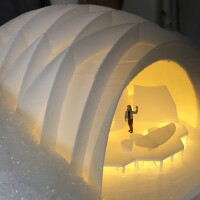Mojave's Rocketeers

Relive the excitement of man’s first steps on the moon and the long journey it took to get there with 20 new hours of out of this world programming on KCET's “Summer of Space" Watch out for “American Experience: Chasing the Moon” and a KCET-exclusive first look at "Blue Sky Metropolis," four one-hour episodes that examine Southern California’s role in the history of aviation and aerospace.
The Mojave Desert is widely known as a military and aerospace testing site for a variety of supersonic aerial projectiles. Alongside these military and commercial activities, amateur rocketeers, including scout troops, off-the-clock aerospace engineers, college and university rocketry club members, and others congregate at several locations in the Mojave Desert to launch rockets, both large and small. This interest in amateur rocketry has paralleled aerospace and military weaponry development at regional research centers, such as the Jet Propulsion Lab (JPL) in Pasadena and Lockheed’s Skunk Works in Burbank from the 1940s onward.
Considered the oldest of these amateur experimental rocketry groups, the Reaction Research Society (RRS) was founded in 1943. The group had originally evolved out of the Southern California Rocket Society of Glendale. By 1955, the non-profit RRS had obtained permits to operate on a public land holding near Cantil, California, near the northwestern edge of the Mojave Desert, where launch and static rocket activities have been continuously conducted since the society’s formation. Now owned by the RSS, this 40-acre site is referred to as the Mojave Test Area (MTA), located within the controlled military airspace of nearby Edwards Air Force Base.

A 1954 Popular Mechanics story on Southern California Rocket Society activities lists rocketry devotees from all walks of life: “Doctors, merchants, mechanics, housewives, stenographers and the like. There is a goodly smattering among them of technicians in the field of aeronautics, people employed by the aircraft and instrument companies.”
Indeed, many of today’s middle-aged participants were inspired to build and launch model rockets while growing up during the height of the Apollo space program from 1969 to 1972. Although this activity is completely affordable for weekend hobbyists, some of the more serious enthusiasts have spent thousands of dollars to launch their rockets in the desert. It is estimated that over 50,000 model rockets have been launched in the U.S. since the mid-twentieth century, when the hobby first took off.

For over twenty years, the Rocketry Organization of California (ROC) has hosted ROCstock, a two-day event where amateur rocketry enthusiasts commune at Lucerne Dry Lake just east of Victorville to launch their diminutive Estesrockets alongside human-sized mega-models capable of breaking the sound barrier. This event, whose motto is “Peace, Love and Rockets,” is one of the largest meet-ups for building and launching recreational amateur rockets in the world. ROCtober is held annually every October. ROCstock occurs twice a year during November and June. On average, these combined ROC events draw up to 600 to 700 young people, along with their parents, mostly from scout troops and civil air patrol groups, who participate or just take in the action.
Read more about the Mojave's rocketeers here.
Top Photo: The 41stROCstock, Lucerne Valley, CA (2015) | Kim Stringfellow


